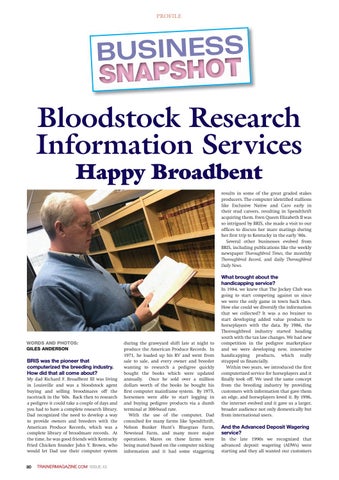PROFILE
BUSINESS SNAPSHOT
Bloodstock Research Information Services Happy Broadbent
results in some of the great graded stakes producers. The computer identified stallions like Exclusive Native and Caro early in their stud careers, resulting in Spendthrift acquiring them. Even Queen Elizabeth II was so intrigued by BRIS, she made a visit to our offices to discuss her mare matings during her first trip to Kentucky in the early ’80s. Several other businesses evolved from BRIS, including publications like the weekly newspaper Thoroughbred Times, the monthly Thoroughbred Record, and daily Thoroughbred Daily News.
What brought about the handicapping service?
WORDS AND PHOTOS: GILES ANDERSON
BRIS was the pioneer that computerized the breeding industry. How did that all come about? My dad Richard F. Broadbent III was living in Louisville and was a bloodstock agent buying and selling broodmares off the racetrack in the ’60s. Back then to research a pedigree it could take a couple of days and you had to have a complete research library. Dad recognized the need to develop a way to provide owners and breeders with the American Produce Records, which was a complete library of broodmare records. At the time, he was good friends with Kentucky Fried Chicken founder John Y. Brown, who would let Dad use their computer system 80
TRAINERMAGAZINE.COM ISSUE 43
during the graveyard shift late at night to produce the American Produce Records. In 1971, he loaded up his RV and went from sale to sale, and every owner and breeder wanting to research a pedigree quickly bought the books which were updated annually. Once he sold over a million dollars worth of the books he bought his first computer mainframe system. By 1975, horsemen were able to start logging in and buying pedigree products via a dumb terminal at 300-baud rate. With the use of the computer, Dad consulted for many farms like Spendthrift, Nelson Bunker Hunt’s Bluegrass Farm, Newstead Farm, and many more major operations. Mares on these farms were being mated based on the computer nicking information and it had some staggering
In 1984, we knew that The Jockey Club was going to start competing against us since we were the only game in town back then. How else could we diversify the information that we collected? It was a no brainer to start developing added value products to horseplayers with the data. By 1986, the Thoroughbred industry started heading south with the tax law changes. We had new competition in the pedigree marketplace and we were developing new, innovative handicapping products, which really strapped us financially. Within two years, we introduced the first computerized service for horseplayers and it finally took off. We used the same concept from the breeding industry by providing customers with information that gave them an edge, and horseplayers loved it. By 1996, the internet evolved and it gave us a larger, broader audience not only domestically but from international users.
And the Advanced Deposit Wagering service? In the late 1990s we recognized that advanced deposit wagering (ADWs) were starting and they all wanted our customers
